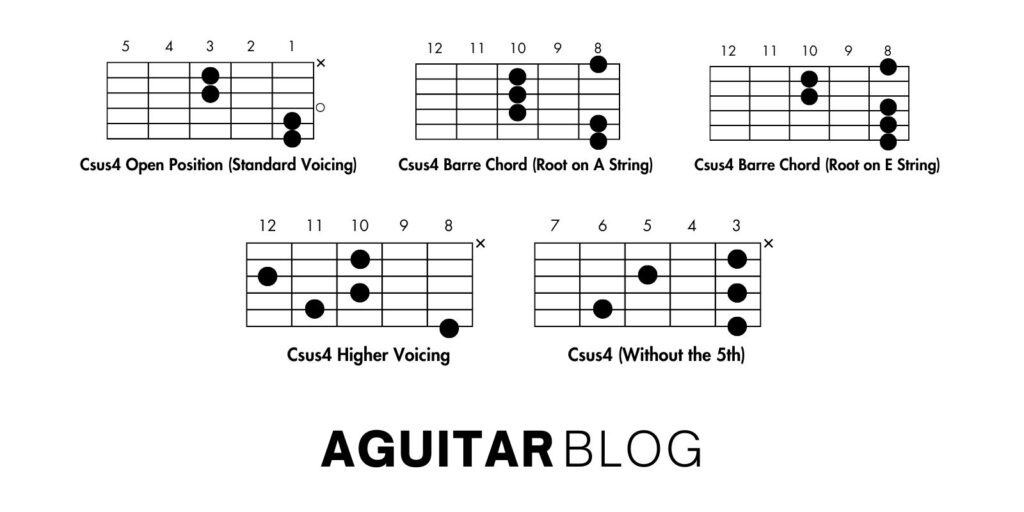The Csus4 guitar chord (C suspended 4th) is a unique and powerful chord that adds a sense of tension and anticipation to your music. Unlike major or minor chords, the suspended chords have a suspended note, which makes them feel unresolved, often leading to a satisfying resolution. In this guide, we’ll break down how to play the Csus4 chord, common mistakes, tips, and variations.
What is a Csus4 Guitar Chord?
The Csus4 chord replaces the major third (E) from the C major chord with a perfect fourth (F), creating a more open and ambiguous sound. The chord feels like it’s hanging in the air, waiting to resolve either back to C major or another chord. This sense of tension makes the Csus4 chord great for transitions and building dynamics in a song.
Csus4 Formula:
- Root (C)
- Perfect fourth (F)
- Perfect fifth (G)
How to Play the Csus4 Guitar Chord
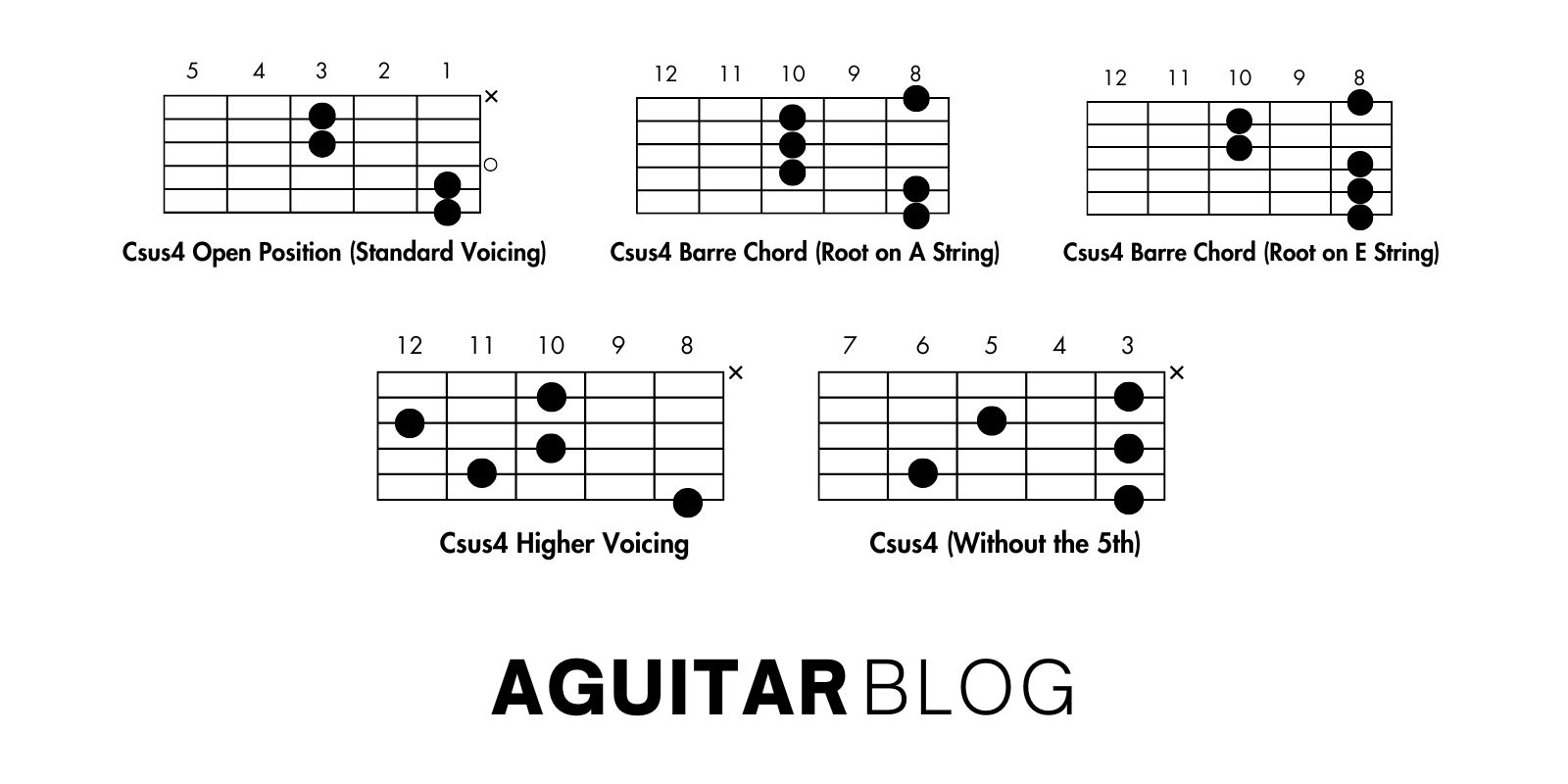
The Csus4 (C suspended 4th) chord is a variation of the standard C major chord where the third note (E) is replaced by the fourth note (F). This creates a feeling of tension and openness, as the chord lacks a clear major or minor tonality. It’s widely used in various genres such as pop, rock, and folk to add movement and emotional depth.
Here are the most common variations of the Csus4 chord on guitar, with detailed explanations on how to play them.
Csus4 Open Position (Standard Voicing)
This voicing produces an open and ringing sound, which is commonly used in folk, pop, and acoustic music. The suspended nature of the chord adds a feeling of tension that resolves beautifully to a C major chord or others in a progression.

How to Play:
- Leave the low E string muted (do not play it).
- Place your ring finger on the 3rd fret of the A string (C note).
- Place your pinky on the 3rd fret of the D string (G note).
- Place your index finger on the 1st fret of the B string (C note).
- Leave the G string open (G note).
- Strum all strings except the low E string.
Csus4 Barre Chord (Root on A String)
This voicing is a more robust version of the Csus4, providing a fuller and more powerful sound, ideal for rock and jazz. The barre chord creates a more controlled, precise sound, making it perfect for rhythm playing or building up dynamics.

How to Play:
- Use your index finger to barre all the strings at the 8th fret.
- Place your ring finger on the 10th fret of the D, G, and B strings.
- Strum all strings starting from the A string.
Csus4 Barre Chord (Root on E String)
This voicing has a sharper, brighter quality and is commonly used in more modern pop and rock. The barre structure gives the chord a more aggressive feel and is useful in contexts where precision and volume are necessary.
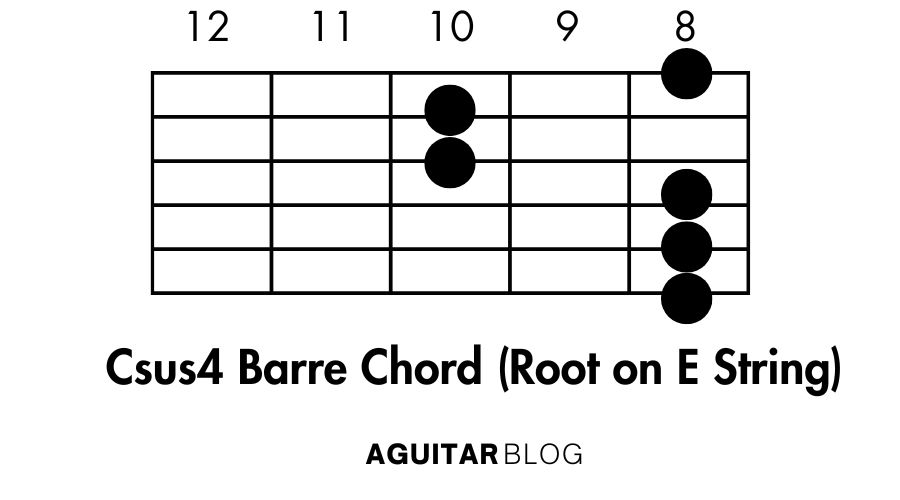
How to Play:
- Use your index finger to barre all the strings at the 8th fret, starting from the low E string.
- Place your ring finger on the 10th fret of the A string.
- Let the D and G strings be muted by your index finger, and press the B and high E strings on the 8th fret.
- Strum all the strings starting from the low E string.
Csus4 Higher Voicing
This higher voicing of Csus4 has a bright, sparkling sound that works well in melodic and solo contexts. The chord is great for creating an ethereal or atmospheric feel and can be used in light rock, indie, or jazz settings to add complexity.
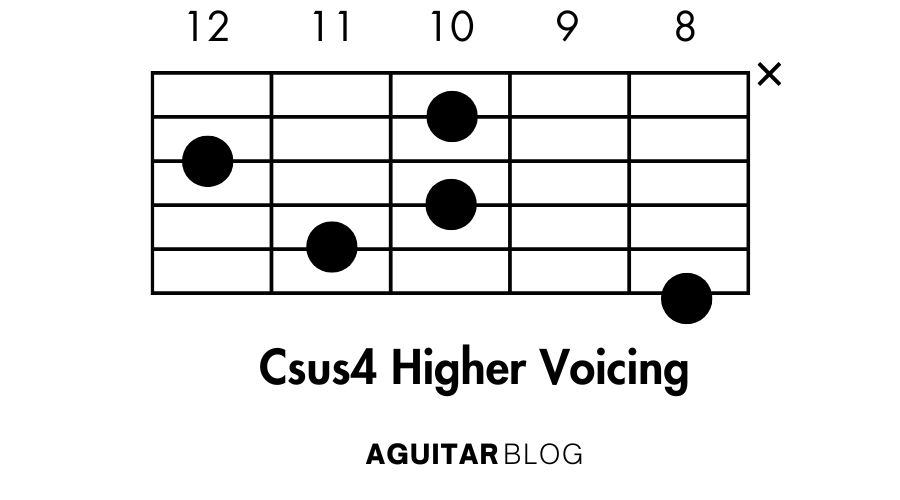
How to Play:
- Place your index finger on the 10th fret of the A string (C note).
- Place your middle finger on the 10th fret of the D string (F note).
- Use your ring finger to press the 12th fret of the G string (G note).
- Use your pinky to press the 11th fret of the B string (Bb note).
- Strum from the A string down.
Csus4 (Without the 5th)
Omitting the 5th note (G) makes the chord sound even more suspended and open. It’s less resolved and leaves more room for harmonic tension, which makes it ideal for transitional passages or building suspense in a progression.
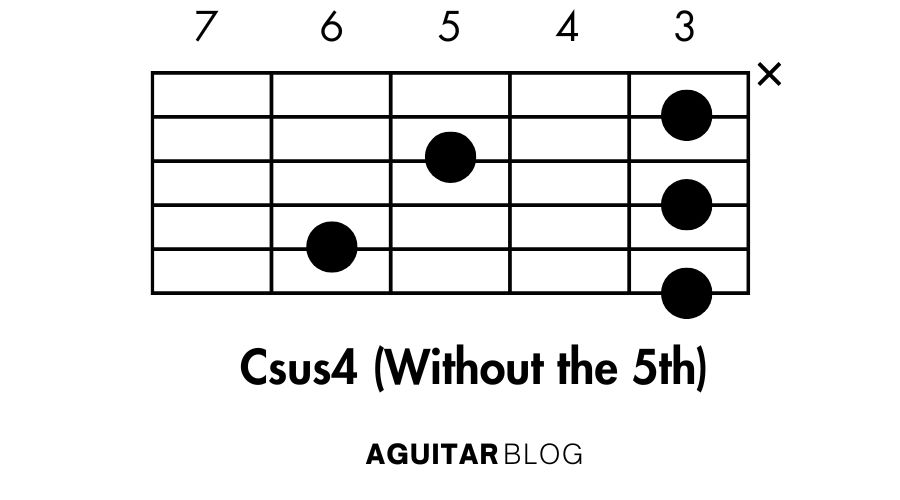
How to Play:
- Leave the A string open (C note).
- Use your index finger to press the 3rd fret of the G and high E strings.
- Use your middle finger to press the 5th fret of the D string (G note).
- Place your pinky on the 6th fret of the B string (Bb note).
- Strum only the D, G, B, and high E strings.
The Csus4 chord is an incredibly versatile and expressive chord that can add depth, movement, and tension to your playing. From open voicings that provide a relaxed, open sound to barre versions that offer power and clarity, there are many ways to approach the Csus4 chord on guitar. Whether you’re writing a song, playing in a band, or just experimenting with different sounds, mastering the various voicings of Csus4 will unlock a wide range of harmonic possibilities and add emotional nuance to your music.
Top 5 Songs Featuring the Csus4 Guitar Chord
The Csus4 chord, with its suspended fourth, creates a unique tension that feels unresolved yet harmonically satisfying. This chord is often used to add emotional depth, build anticipation, and create movement in songs. Below are five iconic tracks where the Csus4 plays a pivotal role in shaping the song’s mood and progression.
“Every Breath You Take” by The Police
Chords Used: The Csus4 is used in the intro and throughout the verses of the song.
Why It Works:
The Csus4 creates a haunting, suspended quality that perfectly complements the song’s lyrical theme of longing, obsession, and surveillance. The unresolved tension of the Csus4 chord mirrors the persistent, relentless feeling described in the lyrics, making it an integral part of the song’s atmosphere.
The transition between Csus4 and C is subtle yet powerful, making the resolution feel even more impactful.
How It Enhances the Song:
The suspended chord adds a sense of uncertainty and mystery to the song’s harmonic structure. It drives the emotional intensity of the lyrics, giving the music an eerie yet captivating feel. As the chord resolves to C, it gives the song a sense of clarity, creating a satisfying balance of tension and release.
“Let It Be” by The Beatles
Chords Used: Csus4 appears prominently in the chorus and bridges.
Why It Works:
The Csus4 creates a gentle, suspended atmosphere, enhancing the hopeful yet reflective lyrics. The chord serves as a way to build anticipation and heightens the emotional payoff when it resolves to C.
The use of Csus4 in the transition between chords emphasizes the message of acceptance and peace within the song.
How It Enhances the Song:
The Csus4 helps convey a sense of reassurance and reflection, capturing the uplifting spirit of the song while still maintaining emotional depth. It encourages a sense of optimism and surrender, which ties perfectly into the theme of the song about letting go of worries and trusting in a higher power.
“With or Without You” by U2
Chords Used: Csus4 is part of the central progression throughout much of the song.
Why It Works:
The Csus4 chord creates an atmospheric, almost ethereal feeling that complements the song’s emotional conflict. The song speaks of a turbulent, emotional relationship, and the unresolved nature of the Csus4 mirrors this tension, creating an emotional push-and-pull between love and pain.
How It Enhances the Song:
The Csus4 plays a crucial role in the build-up and release of emotional energy throughout the song. The tension it creates is palpable and adds to the sense of yearning and internal struggle expressed in the lyrics. The transition from Csus4 to C allows for the song’s cathartic resolution, offering a release that feels earned after the emotional journey.
“Clocks” by Coldplay
Chords Used: The Csus4 chord is a core part of the progression that drives much of the song’s movement.
Why It Works:
The Csus4 in “Clocks” enhances the song’s feeling of urgency and forward momentum. The suspended nature of the chord creates a sense of time slipping away, which ties in with the song’s themes of time, change, and existential questioning. The song’s rapid pace is complemented by the tension in the Csus4, which creates a push towards resolution.
How It Enhances the Song:
The unresolved nature of the Csus4 chord helps the song feel continuous and moving, symbolizing the relentless passage of time. As the chord resolves to C, it provides a sense of brief clarity before the tension builds again, reinforcing the idea of time being ever-present and unyielding.
“Tears in Heaven” by Eric Clapton
Chords Used: The Csus4 appears in the intro and various parts of the song.
Why It Works:
The Csus4 chord adds an emotional depth and vulnerability to the song. This ballad, written about Clapton’s grief after the loss of his son, uses the suspended fourth to represent a sense of loss and uncertainty. The Csus4 creates a wistful and suspended feeling, which complements the song’s heartbreaking theme of longing for a loved one.
How It Enhances the Song:
The tension of the Csus4 chord perfectly reflects the emotional weight of the lyrics, reinforcing the feelings of sadness, confusion, and hope. As the chord resolves, it gives a momentary sense of peace, but the cycle of suspended chords brings the emotional weight back into focus. This back-and-forth enhances the song’s introspective and deeply emotional atmosphere.
The Csus4 chord is a versatile and essential tool for guitarists, offering a unique way to create tension and emotional depth in your music. Whether you’re exploring open voicings or mastering barre variations, this chord adds richness and character to any progression. Experiment with the different shapes to find the sound that fits your style and unlock new creative possibilities in your playing.
For more tips, techniques, and inspiration, visit Aguitar Blog—your trusted guide to mastering the art of guitar.
SEE ALSO RELATED C CHORDS

